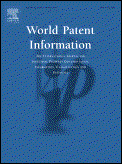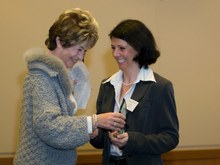Conference report
ICIC - The International Conference for Sciene and Business Information, October 2009, Sitges
Thanks to Michael Blackman and World Patent Information
This was my first visit to the conference for several years. As in past events in this series, it was very well organised, with a goodly number of high quality presentations. There were around 170 participants, a similar number to 2008, and exclusively this year from European Countries and North America. Countries with the most delegates were the UK, Germany, and France (each with 16–18%), and the USA, Austria, and the Netherlands (each with 8–12%). Other countries represented included Canada, Switzerland, Belgium, Spain, Hungary, Norway and Sweden. Surprisingly, around half the delegates were first time attendees. Among the varied themes of ICIC 2009, there was a strong focus on state-of-the-art tools for extracting information and analysis, mining, mapping and visualisation from scientific and technical, especially chemical, information. Since one of the principal raw materials for applying these tools is found in the texts of patents, significant attention was devoted to intelligence derived from patents as an aid to decision making in organisations.
Victor Camlek (Thomson Reuters) started the conference off with an assessment of the impact of the economic downturn onpatenting, both in the existing developed world and the rapidly developing nations such as PR China and India. Current indicators suggested that these developing economies could fare better than developed countries because they are more used to responding quickly to change circumstances. So although the rate of increase in India and PR China will slow down, it will still be enough to ensure that by 2050, PR China will be way ahead of the USA – in terms of numbers of patent applications published – with India close on the heels of the USA.
Martin O’Malley (Elsevier) looked at the way that they had progressed from 1638 (1000 articles) to 2009 (1.5 million articles), and this despite the many competitors in the publishing market. He attributed some of this to the established high quality peer review process at Elsevier. They are working hard on maintaining and creating efficient infrastructures, to building partnerships with other organisations, and to ensuring sustainability.
The current interest in ensuring that high quality data is entering the scientific and patent database input streams was reflected in a presentation by Sabine Brünger-Weilandt (FIZ Karlsruhe, Germany). She explained that services and products in which quality was assumed to be high were around us all everyday (e.g., in travel, water supplies and medicines), and that the increasing demand for high quality in technical and patent databases was a natural development to be expected by the end-users. She also quoted Peter Drucker, who noted that ‘‘Quality in a product or service is not what the supplier puts in. It is what the customer gets out and is willing to pay for.” what the supplier puts in. It is what the customer gets out and iswilling to pay for.”1
Karen Blakeman (RBA Information Services, UK) reviewed the current value of blogs, twitter and other web 2.0 services and pointed out that it is worthwhile keeping a close eye on information about you and your organisation, as well as your main competitors, being disseminated in this way.
A more specific application of wikis, etc. was provided by David Walsh (Pfizer, UK) in which he described the Pfizerpedia Patents Semantic MediaWiki. In building a market for intellectual property, Jean-Yves Legendre (L’Oreal) reported research on comparing the various patent portfolio valuations and the increasing appreciation of the value, and significance, of IP. Monika Hanelt (Agfa Graphics, Belgium) discussed the difficult challenges faced by patent searchers when the characterizing feature to search is defined as parameters or parameter ranges (such as a generally knownpolymer X, characterised by property A having values between A0 and A00), or is defined by reference to features of a drawing or figure, as such items are not reliably indexed or otherwise searchable.
In a couple of presentations on the challenges of searching Markush structures, Szaboles Csepregi (Chem Axon, Hungary) and Marc Zimmermann (Fraunhofer Institute SCAI, Germany) outlined the nature of the continuing process of defining, manipulating and searching such structures, and of interpreting the answer sets obtained. Amongst the other patent-oriented presentations, Ian Pearce (Dialog) spoke about ‘patent research: how a patent document resists searching’. While the structure and disclosures in patents make them a valuable source for many different types of search, this presentation noted some potential pitfalls for the searcher. These included poor or misleading titles (e.g., ‘Unknown’), poor abstracts (sometimes just reciting claim 1), and wording used in claims and description which – by chance or by intent – does not use the usualwording for the particular technical field. Citations are another area that Ian mentioned in which inventors, attorneys and examiners can have widely different interpretations, with consequent uncertainty in analysis based on these citations.
The conference was rounded off by a presentation from Mihai Lupu (Information Research Facility, Vienna) in which he described the experiences of the TREK (Chemistry track) in the comprehensive evaluation of information retrieval tools on chemical patents and related scientific literature. The evaluation has focussed on text retrieval recall, precision and efficiency. More specific results are expected to be available early in 2010.
The conference was in the usual format, with two and a half days of lectures, interspersed with new product and service presentations, and optional workshops before and after the conference. All in all, this was a varied and stimulating conference covering a wide, but relevant, range of topics in the fields of chemical and patent information retrieval, and related topics and developments. In association with the conference there was a useful exhibition in which stand holders had a large room in which to display their wares.
Exhibitors included Aureus Pharma, CAS/STN, Chem Axon, CPA-Global, Elsevier, EPO, Info Chem, Intellixir, Knovel, LexisNexis, Matrixware, Questel, Swedish PRV, Thomson Reuters, IRF, and Wiley-Blackwell.
This was the last of this series of more than 20 ICIC conferencesto be organised by Harry Collier and Infonortics. He was thanked heartily by the participants for his efforts over many years in organizing these successful conferences. The baton will be taken up by Christoph Haxel for next year’s conference in October in Vienna, Austria, and we wish him all the best in this challenging task.
Michael Blackman
45 Kenwood Drive, Beckenhem BR3 6QV, United Kingdom





